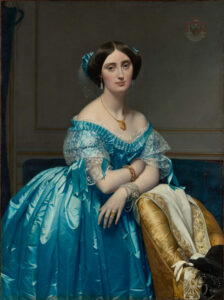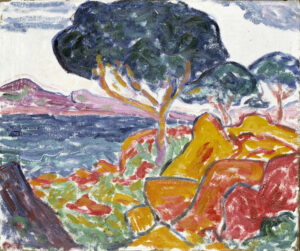This work presents a striking scene of Tahitian women at the water’s edge.
The composition is dominated by a standing figure seen from behind, her golden-brown body creating a powerful vertical element against the vibrant blues and greens of the landscape. She stands on a red cloth with yellow patterns, while two other figures sit nearby. The chromatic contrasts—the warm oranges and browns of the bodies against the cool blues and greens of the water and vegetation—create a powerful visual rhythm.
The artist employs a resolutely non-naturalistic approach, with simplified forms, flattened perspective, and bold planes of color that reject academic traditions. The scene captures a moment of daily life transformed into something monumental and symbolic through this stylized treatment.
Further details:
- Tahitian Women Bathing, by Paul Gauguin, 1892
- 109.9 x 89.5 cm
- The Metropolitan Museum of Art, Fifth Avenue, New York, not currently on display
- https://www.metmuseum.org/art/collection/search/459100
Paul Gauguin (1848-1903) created “Tahitian Women Bathing” in 1892 during his first stay in Tahiti, where he had arrived in 1891 seeking to escape European civilization. Disillusioned with Western society and in search of what he considered more “primitive” and authentic ways of life, Gauguin’s Tahitian works reflect his complex and often problematic vision of Polynesian culture.
This painting illustrates his post-impressionist style. Though celebrated for their formal innovations, Gauguin’s Tahitian works are today also critically examined for their colonial perspective and exoticizing gaze on the indigenous peoples depicted.







